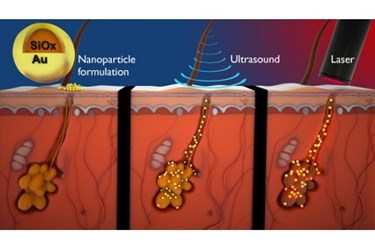Combining Gold, Ultrasound, And Lasers To Treat Acne

Scientists have developed a new acne treatment system that uses ultrasound in conjunction with gold-covered particles and lasers. Early results suggest that the treatment could lessen the frequency and intensity of outbreaks without the potential side-effects of current acne treatments.
Researchers from University of California, Santa Barbara (UCSB) collaborated with private medical device company Sebacia to develop a novel approach called photothermolysis using Sebacia’s proprietary gold-covered silica particles. The treatment targets the overproduction of sebum, an oily substance secreted by sebaceous glands, which can harbor bacteria and clog pores.
Photothermolysis uses low-frequency ultrasound to push the gold-covered silica particles into the sebaceous glands, according to an article in the UCSB Current. The process then uses lasers to heat up the particles using surface plasmon resonance, which essentially disabling the sebaceous glands.
“If you deactivate these overproducing glands, you’re basically treating the root cause of the acne,” said Samir Mitragotri, professor of chemical engineering at UCSB and lead author of the study.
Earlier this year, Sebacia announced positive results from two independent clinical studies conducted in Europe that tested the efficacy and safety of gold-covered silica particles as an acne treatment.
According to Anthony Lando, Sebacia’s CEO, the treatment demonstrated “a robust and significant reduction in the appearance and occurrence of inflammatory acne lesions, and the treatment is well tolerated.”
Mitragotri commented that USBC’s unique collaboration with Sebacia had “established the foundation of a novel therapy” by adding ultrasound to the treatment process.
In a pilot human clinical study published in the Journal of Controlled Release, researchers found that the treatment was effective in “inducing photothermal disruption of sebaceous glands without damaging collateral skin.”
The new method provides many advantages over existing treatments, Mitragotri told the Current. It does not dry or irritate the skin, and users do not run the same risk of resistance often caused by antibiotics or other pharmaceutical interventions. He also said the treatment could be particularly effective in hard-to-treat acne cases that resist other forms of treatment.
“It’s highly local but highly potent as well. I think this would be beneficial in addressing the concerns regarding other, conventional treatments,” said Mitragotri.
According to the American Academy of Dermatology (AAD), acne is the most common skin disorder in the U.S., affecting between 40 million and 50 million Americans. The AAD estimates that the total yearly cost of acne treatments exceeds $2.2 billion.
Image credit: Peter Allen Illustration
